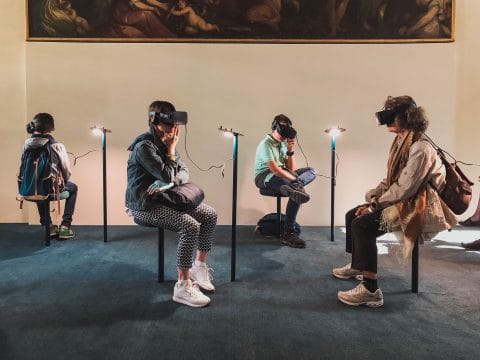 Are you searching for tips on how to create and maintain virtual relationships with employees, consumers, and/or clients in 2020?
Are you searching for tips on how to create and maintain virtual relationships with employees, consumers, and/or clients in 2020?
You found the right article!
2020 ushered in a sea of change where people around the world converted to virtual work environments. Correspondingly, these individuals are undertaking a semi-augmented reality consisting of digital displays. We are witnessing substantial growth in experiencing life, (work, relationships, education, entertainment, and how we acquire things) through innovative technologies. We know, technology has and will always continue to move forward. In order to adapt, we must ask: what can humankind reconstruct to accommodate the virtual revolution?
How do we utilize our advancements and transform the ways we reinforce healthy relationships with everyone vital to our business’ prosperity? Specifically: our employees, consumers, and clients?
In this article, we explore solutions that highlight meaningful virtual video-chat optimization and examples of activities, meetings, and conversations including structure and etiquette that promote authentic relationships. Additionally, we inspect virtual content and enhancement solutions, emphasizing scalability, and purchase behaviors through analyzed data.
How to create and maintain virtual relationships with employees?
First, let’s think about our employees. Visualize the individuals that comprise our teams. Ask, do we know their individual goals? Can we perceive their personal struggles within work and home? Do we know the issues affecting their community? Are employees able to effectively communicate with leaders or peers? Do employees receive authentic feedback or resolutions?
A majority of employees are working in remote, virtual environments and are confined to their homes. Therefore, it is incumbent upon employers to ensure their employee’s overall mental and physical wellbeing. Employees play an essential role in the successful development and growth of an organization. By respecting employees’ individuality, the employees will reflect with positive, healthy levels of job satisfaction and effort. This may also drive higher employment demand for a company. Amy Blackburn refines this idea in her article “What is the Number One Trait That Makes for Employee Satisfaction?” (business.com, 2015), Blackburn states, “understanding the psychology of your workforce is critical, and it helps to know that a steady paycheck is no longer the determining factor for why employees gravitate to certain companies.”
Create and Maintain Virtual Relationships: Virtual Video Chat
Global thought collaborative Keith Ferazzi records in his article “How Virtual Teams Can Create Human Connections Despite Distance” (Harvard Business Review, 2014). In a Unify survey of knowledge workers, 79% of participants reported working always or frequently in virtual teams. But, only 44% found virtual communication as productive as face-to-face communication. However, in the conclusion of Lauren Sherman’s research journal “The Effects of Text, Audio, Video, and In-Person Communication on Bonding Between Friends” (Cyberpsychology: Journal of Psychosocial Research on Cyberspace, 2013). The participants of this study obtained similar experiences through video-chat compared to in-person communication. Sherman stated, “participants felt most bonded during the in-person and video-chat conditions.” The conclusion we can draw from these two sources is: Employees are not currently experiencing value in virtual video-chats. But, video-chat is the leading tool for quality communication next to in-person meetings.
So, what are we missing in virtual video-chat?
Answer: Quality.
Wayne Baker, PH.D. records in his article, “How to Connect Meaningfully in a Virtual Meeting” (Psychology Today, 2020), his guidelines on how we can maintain “meaningful” or quality virtual meetings. Baker states, “it’s more important now than ever before to connect meaningfully in a virtual meeting or gathering.” What makes a meaningful moment according to Baker is a “human moment” or, more loosely defined, a moment of presence, and focused attention.
The goal we must strive to achieve with virtual video meetings is utilizing video-chat to facilitate and create virtual environments that promote true open conversations. These conversations acknowledge the individual realities of the team. Baker writes, “Acknowledging reality shows empath. It shows that we are all in this together,” (Psychology Today, 2020). Any negativity or bias views/reactions must be avoided within conversations. Everyone’s “truth” is to be respected. It is everyone’s responsibility to listen and perceive how individuals are feeling while remaining conscious of their thoughts and needs.
If a controversial disruption occurs within video-chat, politely and respectfully redirect the conversation. Ensure everyone recognizes the purpose of open conversations is to listen and empathize with individual ideals of the team, and not to reason our own ideals with another.
Tips for Meaningful Virtual Video Chats
- Consciously create open conversations – discuss current world events and/or issues within communities. Allow everyone to address the topics affecting them, and recognize, offer, or create proactive solutions. (Leaders can promote optional and conditional proposals for employee solutions. These solutions will correspondingly benefit their individual worth/growth within the company while addressing their current setbacks/issue.)
- Host virtual happy hours – reimburse or cater libations and/or snacks for employees.
- Learn – Continuously promote learning through examples. Assign a different employee each week to give an educational presentation on something unique to them, or unique to their profession. (Encourage praise toward all individual talents).
- Organize team hikes, workouts, or activities to be conducted individually, while connected through virtual video-chat (maintaining social distancing and PPE). Many of us live in a reality of screens. We are forced to contend with work, entertainment, and exercise through digital displays. Encourage teams to ground themselves to nature and their bodies.
For more ideas on virtual video-chat activities, I encourage you to visit Jamie Wilde’s short article on “32 Ways People Are Using Zoom Besides Work” (Morning Brew, 2020).
How to create and maintain virtual relationships with consumers and clients?
At their inception, companies like Facebook, Amazon, and Netflix experienced negative conflicts of laughter and doubt for their products. Currently, these companies are highly influential powerhouses in the American economy. They represent proof that virtual technologies will continue to progress throughout the development of humanity. The individual presence within the virtual world is and will continue to expand greatly, due to current world events (COVID-19 and business going remote).
Now, is an essential time to “clean” or optimize a business’s virtual presence. According to Jimmy Rodela’s research from 2015 conducted by business.com, “77% of people read online reviews before buying.” According to Mark Banschick, M.D in his article, “Why People Buy” (Psychology Today, 2016), “the buying decision is the result of both how well information was transferred from the business to the buyer, and the believability of the information.”
Establishing and maintaining virtual relationships with consumers and clients virtually corresponds to the business’s ability to produce authentic and reputable value. In order to create or maintain relationships with consumers or clients, a business must focus on how the products/services are virtually projected and how customers and clients desire to receive the information presented/received.
How to create and maintain virtual relationships with consumers and clients? Video Content
According to Oberlo’s 2020 statistic report, 85% of all internet users in the US watch virtual video content monthly. It was also recorded that 54% of consumers want to see more video content. While the demand for video content consumption is increasing. Businesses are also experiencing an increase in positive results in relation to video content. 88% of video marketers are satisfied with their overall ROI on social media and 8 out of 10 people purchase software or apps after watching a branded video.
However, publishing video content isn’t enough to establish or maintain the necessary relationships needed for progression. To optimize video content, we must ask, what does the audience want to know, what do they already know, and how do they prefer to receive that information? Once this information is gathered, brainstorm ideas on creating messages that encourage the audience to engage with your video or website.
Be creative and unique, but above all, display an authentic and actionable solution that showcases meaning, humanity, and vision. “Once a consumer believes that a product can help them – they actually see themselves in the future without the problem” (Banschick, Psychology Today, 2016).
Some ideas on video content include showcasing/introducing products/services, introducing team members, sharing the company’s vision, and/or reasoning behind developments.
Create and Maintain Virtual Relationships: Virtual Video Chat
Virtual video-chat technologies are another tool businesses can optimize, create, and maintain relationships with consumers and clients. Virtual video-chats enable opportunities to assess and construct authentic personal messages for your audience in real-time. This advantage helps create meaning and context within the conversation. Banschick exclaims virtual video-chats, when done right, have the ability to “… become personally meaningful, through constructivist learning,” (Psychology Today, 2016). Virtual video-chats promote active engagements between participants, thus stimulating and optimizing the conversation, information, and emotions expressed.
Virtual video-chat introductions create a context for the viewer and help affirm confidence in what they are purchasing. By conducting virtual video-chats with consumers and clients, businesses can create a shared value/meaning for their products expressed through the conversations.
Tip: Practice empathy to guide the discussion and create a comfortable virtual environment.
Tips on etiquette and creating “meaning” in virtual video-chat:
- Do not rush – maintain an effort to set a relaxed discussion pace and encourage open conversations that do not follow the planned discussion memo.
- Introductions – ask everyone to introduce themselves and give a brief background on whatever they are comfortable with sharing (like where they are/from, education, past professions, hobbies, and how they are faring in the world). Lead the discussion by first sharing information about yourself, that you hope to receive from them (lead by example).
- Facilitate – keep a loose memo of topics to address but also allow the conversations to evolve. The trick is to keep the conversation flowing naturally and authentically, maintaining a relaxed ambiance to the call.
Why is creating and maintaining virtual relationships with employees, consumers, and clients important in 2020?
The world is in a constant state of disruptive evolution. This sometimes makes us feel discouraged or lost. But, the inclination of humanity’s success has always featured the ability to communicate and create bonds/relationships with our communities. Now, more than ever, people need and crave connection. Connection to each other. Connection with the products we buy. And connections with the companies we buy from. 2020 is a year that has disrupted the way we exist in the world. Smart companies that know how to create and maintain virtual relationships, and who understand the needs and aspirations of people, can and will lead us to the next evolution of humanity.

 Are you searching for tips on how to create and maintain virtual relationships with employees, consumers, and/or clients in 2020?
Are you searching for tips on how to create and maintain virtual relationships with employees, consumers, and/or clients in 2020? 







